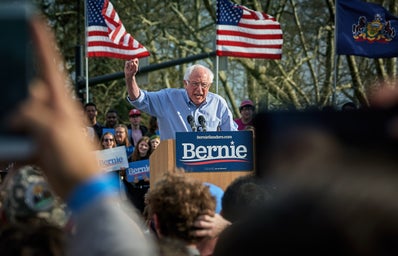Like many other college students, I am part of the #bernie2020 group—a cultural movement pushing for the presidential nomination of lifelong politician Bernie Sanders. It’s quite ironic that despite being the oldest candidate, Sanders has managed to acquire the younger generation’s support. Take the Huskies for Bernie organization for example; the club managed to bring notable ice-cream makers, Ben and Jerry, right here on campus, as a way to endorse Bernie: an event where at least 200 students showed up. It’s enough to say Sanders represents what most Millennials and Gen-Zers desire: universal healthcare, affordable education, and stable economic positions. But to understand Bernie’s success, we have to understand the current state of the American youth.
In an article by Forbes Magazine, author Jack Kelly writes, “Younger people face the frightening realization that they may be the first generation to have a lower standard of living than their parents. They are understandably concerned about how they can be self-sufficient, financially independent and live the American Dream, which was promised to them”. Kelly’s ideas aren’t far-fetched: the combination of crushing student loans, minimum-wage jobs and accumulating home/rental costs has a massive impact on Millennials and Gen-Zers alike. As of now, college tuition rises almost 8% each year; meaning prices double every nine years. Think about it this way: for a baby born today, college costs will be more than three times current rates when the child matriculates in college. On a nationwide scale, the total student loan debt in the U.S. now stands at more than $1.6 trillion, states CNBC.
But that’s just simple inflation, right? As prices rise, it’s only inevitable for tuition to rise as well. The problem is that this rate isn’t parallel to the rate wages are increasing. For reference, another article by Forbes proclaims that the price of college is growing almost 8 times faster than wages. In fact, “while the cost of a four-year degree exploded to $104,480, real median wages only went from $54,042 to $59,039 between 1989 and 2016.” In addition to the cost factor, since more high school graduates attend college than ever before, the value of a degree has been diluted.
Let’s say you forgo college though; you don’t have to worry about student loans or debt. Instead, you have to worry about other costs. If you decide to live in any large urban city, the cost of living is drastically high, to the point at which many young people don’t have enough money for savings or retirement plans. Without having that extra money, you might not be able to participate in the stock market, a life-saver for aging Boomers who had money to invest. It’s also important to note that our self-proclaimed “middle-class” has been shrinking year after year, a phenomenon of rising wealth disparity with the rich growing richer and the poor growing poor.
So how does this all relate to Bernie Sanders? Well, he was the gateway for these problems– someone who promised to provide for those of us suffering from crippling debt, high medical costs, you-name-it. What Sanders may lack in traditional political charisma is more than compensated for with undoubtable commitment and determination (read: his several activist movements in the 1900s). For college students trying to stay afloat amongst a sea of debt and navigating their way through the workforce (especially during the looming recession), Sanders is refreshing — a trait that isn’t as transparent in the other candidates. In the beginning he thrived. Rallies of supporters were found in every major city, and I even remember students knocking on my door to hand out flyers. Unfortunately, time, and a lack of voters, started to catch up and he found himself stuck at a crossroads. It was a matter of either dropping out of the race completely or continuing on with fewer delegates than his competitor.
As of April 8th, Sanders has chosen the former. I was informed of this from the countless Instagram stories and Twitter posts from my peers the morning I woke up. It seems almost like a cultural reset in a way: a figure we looked up to so much has failed us. Now we’re left alone to fend for ourselves in an attempt to figure out the future for the next, at least, four years.
But maybe Sanders dropping out of the race doesn’t mean forgoing his ideas, but rather a way to revisit progressive ideologies. In the past few months, the topic of Democratic Socialism has been on the rise. Key figures in the White House who embody this mindset include Rep. Alexandria Ocasio-Cortez (otherwise dubbed “AOC”), Rep. Ilhan Omar, and many more. It’s impossible to ignore the climate change movement in recent years, as the problem has only gotten stronger. In the midst of COVID-19 is the issue of healthcare and wages. As the years go by, it’s hard to passively accept capitalism as it continues to push people out of the workforce and economy.
Maybe Sanders himself isn’t what we need to progress, but rather his messages. Ruchir Raturi, a computer science student at the University of Maryland and an avid Bernie supporter, states, “It’s definitely a devastating blow, but the revolution doesn’t end with Bernie. We need to continue working for a better future.” When asked how he would respond to those still looking to fight for the ideas shared by Sanders, he says, “There’s a lot you can do from working with your local DSA (Democratic Socialists of America) to just keeping the conversation alive. It’s important to not settle for an idea, but rather fight for what you think is right”.
Edit: At the time of publishing this article, while Sanders has not completely dropped out of the race, he has suspended his campaign indefinitely, meaning he will no longer host rallies or campaigns.


